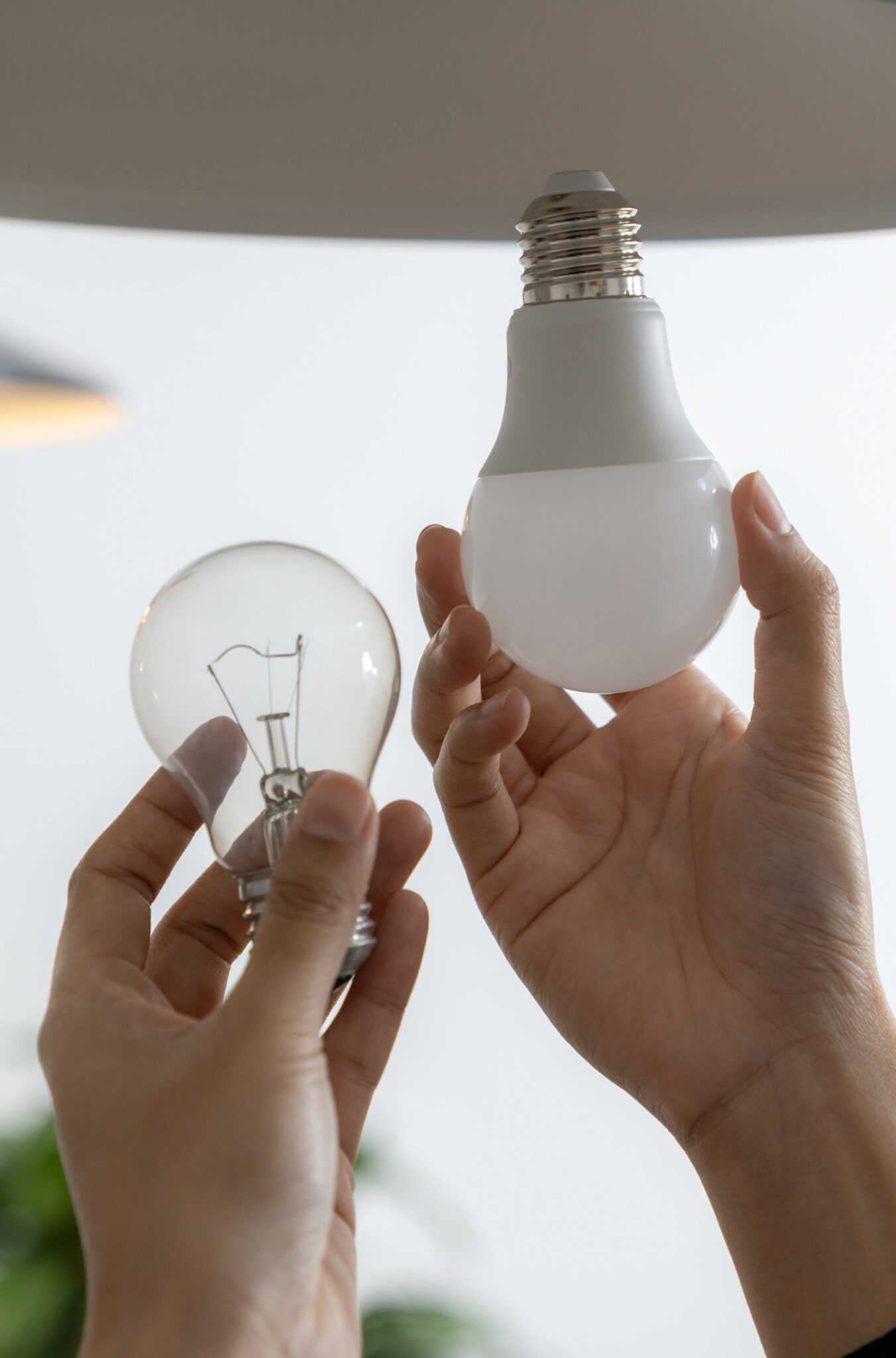Relamping
Éclairez vos performances énergétiques.
Comprendre LE RELAMPING
Moderniser un parc d’éclairage obsolète est l’un des leviers les plus simples et les plus rapides pour améliorer l’efficacité énergétique d’un bâtiment. Le relamping consiste à remplacer les luminaires existants par des solutions LED à haute performance : plus économes, plus durables et mieux pilotables. Ce geste technique permet de réduire jusqu’à 80 % la consommation liée à l’éclairage, tout en améliorant le confort visuel et en assurant la conformité aux normes en vigueur.


POURQUOI LE RELAMPING EST ESSENTIEl
Réaliser des économies immédiates
Les anciens luminaires fluocompacts, halogènes ou à décharge sont remplacés par des LEDs, qui consomment jusqu'à 80% d'énergie en moins. Cette réduction se traduit directement par une baisse de vos factures et un retour sur investissement rapide.
Améliorer le confort et la qualité d'éclairage
Les luminaires LED offrent un éclairage homogène, instantané et sans éblouissement. Grâce à un meilleur indice de rendu des couleur (IRC), ils améliorent le confort visuel et la producticité dans les espaces de travail, tout en réduisant la fatigue oculaire.
Se conformer aux normes en vigueur
Le relamping vous permet de respecter les obligations réglementaires telles que le Décret Tertiaire, qui impose des réductions de consommation énergétique dans les bâtiments de plus de 1 000 m². C’est aussi un levier efficace pour anticiper les futures exigences environnementales.
Notre accompagnement pas à pas
Évaluation et planification
Chaque projet de relamping débute par une étude détaillée du parc d’éclairage existant. Nous réalisons un audit technique pour identifier les types de luminaires en place, leurs performances, leur consommation, ainsi que les zones prioritaires. Cette analyse nous permet de proposer une solution sur mesure, tenant compte des usages spécifiques des espaces résidentiels ou publics concernés (parties communes, extérieurs, voirie…).
Mise en œuvre des travaux
Nos équipes pilotent l’ensemble des opérations, du choix du matériel à l’installation, avec une attention particulière portée à la limitation des nuisances pour les résidents ou les usagers. Grâce à notre expertise terrain, nous assurons une mise en œuvre rapide, sécurisée et conforme aux normes, dans les immeubles d’habitation comme dans les équipements publics.
Suivi et optimisation
À l’issue du chantier, nous pouvons assurer un suivi des consommations pour mesurer l’efficacité réelle du relamping. Nous vous proposons également, si nécessaire, des ajustements ou compléments de dispositifs (détecteurs de présence, gradation, gestion automatisée…) afin d’optimiser les économies sur le long terme et garantir une exploitation pérenne des installations.
Une question sur le relamping ?
NOS Solutions de relamping
Éclairage LED performant et durable
Éclairage LED performant et durable
Remplacer les luminaires par des LED dernière génération réduit la consommation de 50 à 80 %. Durables (jusqu’à 50 000 h) et sans maintenance, ces solutions offrent un gain économique pérenne pour les copropriétés et bâtiments publics.
Une démarche écoresponsable
Une démarche écoresponsable
Moderniser son éclairage, c’est aussi réduire son empreinte carbone. Nous sélectionnons des équipements selon des critères de performance mais aussi de qualité environnementale. Enerlis est partenaire d’Écosystème pour assurer la collecte et le recyclage de plus de 90 % des anciens luminaires, conformément aux exigences réglementaires.
Confort, sécurité et adaptabilité
Confort, sécurité et adaptabilité
Un éclairage LED bien dimensionné améliore la qualité visuelle et la sécurité des espaces, tout en s’adaptant à chaque usage grâce à des options de gestion intelligentes (détection, gradation…).
Le mot de l'expert
L’éclairage, un levier clé pour la performance énergétique
FAQ
Une question ?
Passer aux LED présente de nombreux avantages :
● Économies d’énergie immédiates : jusqu’à 80 % de réduction par rapport à un éclairage traditionnel.
● Longévité accrue : durée de vie moyenne entre 20 000 et 50 000 heures.
● Meilleure performance : plus de lumens par watt, allumage instantané, meilleur rendu des couleurs.
● Moins de maintenance : les LED ne nécessitent pas de remplacement fréquent.
● Impact environnemental réduit : moins de composants polluants, recyclage encadré (partenariat avec Ecosystem).
C’est une démarche complète qui vise à améliorer l’efficacité globale de votre éclairage :
● Audit technique du parc existant (puissance, type, état…).
● Mesures d’éclairement et simulations (ex. DIALux®) pour définir l’installation optimale.
● Étude des usages pour proposer des solutions sur-mesure (détection, gradation, apport de lumière naturelle…).
● Choix stratégique du matériel selon vos besoins et objectifs d’économies.
● Chiffrage précis des gains énergétiques attendus.
Pour garantir l’accessibilité et la sécurité, des niveaux d’éclairement sont exigés :
● Cheminements extérieurs et parkings : 20 lux
● Postes d’accueil : 200 lux
● Circulations intérieures : 100 lux
● Escaliers : 150 lux
Le respect de ces seuils est obligatoire pour tout ERP (Établissement Recevant du Public).
L’arrêté du 27 décembre 2018 impose des mesures pour limiter les nuisances lumineuses et préserver la biodiversité.
À retenir :
● Éclairage vers le bas uniquement (flux lumineux orienté à 95 % vers le sol).
● Température de couleur ≤ 3000 K (blanc chaud).
● Extinction obligatoire la nuit : au plus tard à 1h du matin, sauf dérogations.
● Suppression des luminaires obsolètes (type « boule »).
● Seuils d’intensité à respecter dès 2025 : < 25 lm/m² en zone urbaine, < 10 lm/m² hors agglomération.